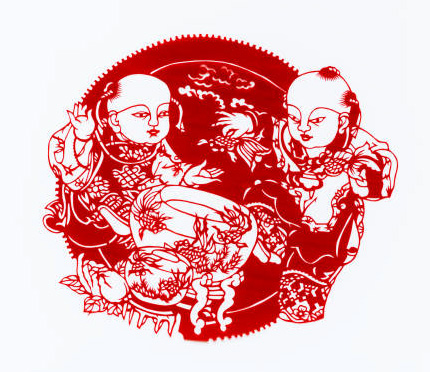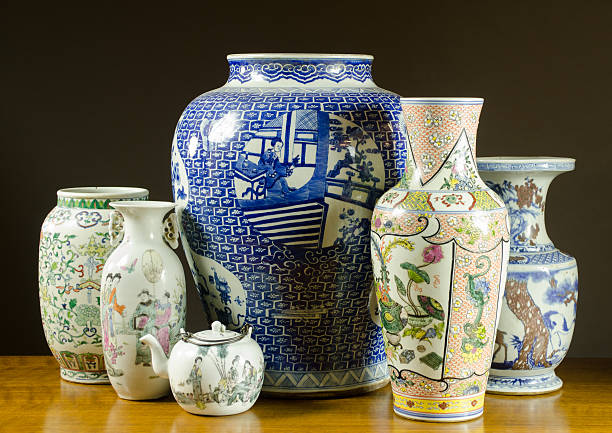Arts
China has a long and glorious history in arts and traditional crafts that represent the nation’s love of beauty. Chinese master artisans handed down their knowledge and skills to the next generation, which preserved the older methods, and made them unique to the Chinese culture.
The areas that represent Chinese culture include:

Bronze Vessels
Bronze Vessels were invented over 5,000 years ago and were intricately decorated with a diverse range of designs and motifs. Bronze was used to make musical instruments, ceremonial offerings and weapons of war.
China Calligraphy
China Calligraphy is a highly stylized form of writing and was developed and improved by eminent calligraphers throughout Chinese history. The tools of calligraphy: writing brush, ink stick, paper, and ink slab, are the “four treasures of study” and are indispensable for calligraphers.
Chinese Cloisonné
Chinese Cloisonné is enamel artwork that is bright and vivid – and favors the the color blue. It is renowned for its use of high-quality material and requires a complex manufacturing process.
Chinese Jade
Chinese Jade symbolizes merit, grace, and dignity and occupies a special position in Chinese society. For more than 4,000 years it has been used to decorate rooms, and is worn as jewelry by people hoping for a blessing.
Chinese Embroidery
Chinese Embroidery originated in the Shang Dynasty (16th – 11th century BC), and now has four major traditional styles: Su, Shu, Xiang, and Yue. Ethnic minority groups such as the Bai, Bouyei and Miao are widely known for their expertise in this area.
Folk Toys
Folk Toys possess represent a combination of artistic appreciation and playful enjoyment. These toys are endowed with numerous meanings that express wishes for a happy and content life.
Chinese Kites
Chinese Kites are constructed of paper and bamboo which are formed into shapes such as swallows, centipedes, butterflies, and other animals. A kite makers’ skill is reflected in the kite’s flexible flying movement, along with how it is painted.
Lacquer Ware
Lacquer Ware first appeared about 7,000 years ago with the primary colors being black and red. Appearing in many different forms – from bowls to paintings – lacquer ware is known for its beauty and durability.
Chinese Lanterns
Chinese Lanterns symbolize the country’s extensive festival culture. With a long history and interesting traditions behind them, lanterns add a festive look to any occasion.
China Music
China Music began some 7,000 to 8,000 years ago. Different dynasties invented unique melodies that were played with traditional instruments.
Chinese Opera
Chinese Opera is recognized as one of the three oldest dramatic art forms in the world. It combines music, art, and literature and is characterized by unique facial makeup and outstanding acrobatics.
Chinese Painting
Chinese Painting is divided into figures, landscapes, and birds and flowers. Each type has its own distinctive characteristics.
Paper-Cuttings
Paper-Cuttings feature patterns such as monkeys, flowers, and figures and are produced by female rural artisans. These cuttings are displayed to express the hopes and wishes of a buildings’ inhabitants.
Chinese Porcelain
Chinese Porcelain began with the Shang Dynasty and is characterized by fine textures, bright colors, and distinctive shapes and styles. Jingdezhen, located in Jiangxi Province, is the Porcelain Capital of the world.
Chinese Pottery
Chinese Pottery has been around for 8,000 years and is regarded as mankind’s oldest artwork. The accomplishments in pottery works include the Terra Cotta Warriors, in Xian, Shaanxi Province, and the Tricolor Glazed pottery of the Tang Dynasty.
China Seals
China Seals are made of metal, jade, animal tooth or horn and are decorated with calligraphy and engravings.
Shadow Puppetry
Shadow Puppetry encompasses shadow play and theatrical property. The vivid shadow puppets, including the figures and scenes, are made from leather. Skilled artists operating the puppets project shadows onto a white screen.
China Silk
China Silk: A silkworm produces 3,280 feet of silk thread in 28-day lifespan. Major local silk products in China include Shu, Yun, Song Brocade and brocades produced by ethnic minorities such as the Zhuang and the Dong people.
Ancient Poetry
In China "poetic education" in the original meaning is learning The Book of Songs. This is the first comprehensive anthology of Chinese poems including 305 poems of the Zhou Dynasty (1122-256 B.C.). It was originally called Shi (Poems) and Shi Sanbai (Three Hundred Poems). Each poem in The Book of Songs was set to music and could be sung. The compilers classified the 305 poems into folk songs, ceremonial songs, and sacrificial songs, according to their contents and the style of the music. Folk songs, which were popular among the people, made up the best part of The Book of Songs, while ceremonial songs and sacrificial songs were used mainly on sacrificial or ceremonial occasions to eulogize the merits and virtues of the Son of Heaven and of his forefathers.
Chinese Kung Fu
Wushu (also known as kung-fu or martial arts) is one of the typical demonstrations of traditional Chinese culture. It is a sport which utilizes both brawn and brain.
Wushu enjoys a long history and great popularity in China. The theory of Wushu is based upon classical Chinese philosophy, while the skills of Wushu consist of various forms of fighting: fist fights, weapon fights, and other fighting routines (including such offence and defence acts as kicking, hitting, throwing, holding, chopping and thrusting) and unarmed combats. Wushu is not only a sporting exercise but also an artistic form. It is used to cure illness as well as for self-defence and is a comprehensive form of culture of the human body.
Chinese Instruments
The Chinese instruments include the erhu, dizi, pipa, and suona. All Chinese instruments are classified by their material construction into eight categories: jin (metal), shi (stone), tu (clay), ge (hide), si (silk), mu (wood), bao (gourd), and zhu (bamboo). Collectively, these eight classifications are known as the ba yin, or “the eight sounds.” All materials used to make these instruments originate from nature, and the significance and symbolism of each is closely tied to its natural origin.
FESTIVALS & ACTIVITIES
See all that is China. Experience the festivities and activities from the Ice & Snow Sculpture Festival to the Festival of Lanterns. For the avid auto fans, there are the Beijing and Shanghai International Automobile Exhibition. Interest in motion pictures? See the Shanghai International Film Festival. See below for more events to match your interests.






















